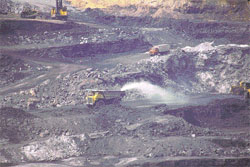A Nationalised Nightmare
A Nationalised Nightmare

The landscape looks straight out of a surrealist painting. Vast tracts of land seem diseased, as if something is eating into the land, leaving behind huge gaping wounds. The air is laden with coal dust - you can easily brush it off your shirt collar. Welcome to the Jharia Coalfields (jcf) of Bihar. Over 144,000 workers toil to extract coal from the cellar of the Earth to feed the nation's power plants, manufacturing units and transport sector. Yet they live nasty, short and brutish lives.
The people living in and around the coalfields of Bihar, West Bengal and Orissa bear the cost of powering the nation's rich, of running the air-conditioners and microwave ovens. But they live a nightmare that the advertisements of the National Thermal Power Corporation never mention. While the coalfields are a blessing for a nation raring to industrialise, it is a curse for the residents.
Pollution levels are very high, be it air or water. Land degradation has reached alarming levels due to opencast mining. According to the 'Environment Management Plan' report prepared by the Bharat Coking Coal Limited (bccl), 29 million tonnes of coal is shipped out every year from jcf. About 60 per cent of this comes from opencast mining that is cheaper and less prone to the kind of accidents that happen in underground mines. But opencast mines leave the environment in a shambles, especially as there is no effort to reclaim land. Similarly, other coal towns such as Dhanbad (Bihar), Raniganj (West Bengal) and Singrauli (Uttar Pradesh) have become environmental nightmares. The increasing reliance on opencast mining has brought down the number of jobs in coalmining from 674,000 in 1988 to 655,000 in 1993.
The problem of large-scale displacement of poor people is the inevitable corollary of the changeover to opencast mining. Already 35,000 people of 27 villages have been displaced to make way for the Ananta, Kalinga, Lingaraj, Bharatpur and South Balanda coalmines in Orissa. Thousands more will be uprooted in the days to come in view of the massive expansion of mining in the area. Those who remain get a worse deal.
Coal dust and high levels of air pollution due to the operation of power and steel plants make the air a strange mix of the carcinogenic and the unbreathable. Water can be a deadly potion of heavy metals as mine discharge is supplied to some village as drinking water (see box: Poisoned water). Rivers have been reduced to channels of effluents from power plants and aluminium smelters.
Worst of all, the authorities seem to have not learned any lessons at all after 200 years of mining coal in India. The same mistakes are being repeated in the new coal belts of Orissa, namely, Talcher and Ib (see box: Orissa's black curse). The level of suspended particulate matter (spm) is twice the standard fixed by the Central Pollution Control Board. A winter morning can be a deadly experience: stark black smog makes breathing difficult. "The crimson morning sunlight never reaches us," complains Bhatruhari Mishra, a science student of Belpahar College that is adjacent to a coalmine.
And if you thought you could escape the air by remaining indoors, forget it. The ceaseless blasting of explosives makes it a really scary retreat. Here, houses collapse every other day. "Life seems impossible here, but we have to live," says Sanat Majhi, a resident of Belpahar coalfield area. Rehabilitation of the local population remains a controversial issue.
India's coalmines were nationalised in the 1970s, and one of the main reasons for this was accidents that killed hundreds of people, one example being that of the Chasnala tragedy in Dhanbad. Another reason was that the mining industry was becoming sick. Clearly, nationalisation has not solved those problems. The big question now is: should mining be privatised? The trade unions oppose it even as several experts say it is the only solution. It looks like a stalemate. With every tonne of coal that is mined, the chances of things improving get more remote because the damage to the environment becomes that much more difficult to undo. The clock is ticking away.







